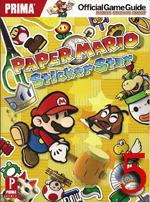 I haven’t really played a Mario game since Super Mario Bros. 3 for the NES. I played Paper Mario: The Thousand Year Door for maybe thirty minutes once, but that hardly counts. I liked what little I played of that GameCube game, and that’s the only reason why I bothered giving Paper Mario: Sticker Star a chance. Since it had been so long since I’ve touched a Mario game, I knew I would need the Paper Mario: Sticker Star strategy guide to hold my hand, as I was sure not playing a Mario game for about twenty years (I’m going to go cry in a corner now) would be more of a hindrance than a help. Nintendo is well known for building upon each game over the franchise’s lifetime (If you don’t believe me, go look at the Legend of Zelda series), so surely there were several elements they wouldn’t teach the player because it is assumed the player is already in the know. I was absolutely right about this assumption, and if it wasn’t for the strategy guide, I would have most likely rage quit the game before finishing the first world. As for the rest of the strategy guide, it nailed everything players will have to do to prepare for each level, complete all collectible side quests, and to beat each boss the first try. I couldn’t have asked for a more perfect strategy guide for my foray back into the world of Mario.
I haven’t really played a Mario game since Super Mario Bros. 3 for the NES. I played Paper Mario: The Thousand Year Door for maybe thirty minutes once, but that hardly counts. I liked what little I played of that GameCube game, and that’s the only reason why I bothered giving Paper Mario: Sticker Star a chance. Since it had been so long since I’ve touched a Mario game, I knew I would need the Paper Mario: Sticker Star strategy guide to hold my hand, as I was sure not playing a Mario game for about twenty years (I’m going to go cry in a corner now) would be more of a hindrance than a help. Nintendo is well known for building upon each game over the franchise’s lifetime (If you don’t believe me, go look at the Legend of Zelda series), so surely there were several elements they wouldn’t teach the player because it is assumed the player is already in the know. I was absolutely right about this assumption, and if it wasn’t for the strategy guide, I would have most likely rage quit the game before finishing the first world. As for the rest of the strategy guide, it nailed everything players will have to do to prepare for each level, complete all collectible side quests, and to beat each boss the first try. I couldn’t have asked for a more perfect strategy guide for my foray back into the world of Mario.
As I previously mentioned, the game really does not provide a tutorial in how to play. There is kind of a tutorial with the turn-based combat, how to initiate battle, how to activate the battle spinner, how to peel stickers, sort your sticker album, etc. However, the game does not teach players how to successfully perform attacks in battle. Those who are familiar with traditional JRPG turn-based battle know that all you have to do is select your attack and watch what happens. In PMSS, players have to interact with the attacks to make them more successful. For example, if you use a Jump sticker, you must continually press the jump button just before Mario lands on the enemy’s head to continue the jump attack through completion. Otherwise, Mario will only jump once and move on. With hammer attacks, players have to press the A button at just the right moment to trigger a powerful hammer swing, or the hammer will slide off the handle and Mario will only smack the Goomba with the stick. The game goes over none of this, as I believe it assumes players already know this from playing other Paper Mario games. After watching my hammer become effectively useless over and over and over, I finally resorted to reading the “How to Play” section in the strategy guide. Lo and behold, I was doing it wrong, and oh hey, look at all these other things I should be doing to help out Mario live longer in battle. To quote another Nintendo game, grumble grumble.
In addition to interactive turn-based play, PMSS really calls on some creative thinking to fully complete some levels, meaning finding all of the Things or opening all potential pathways. For example, to find the Bowling Trophy Thing, you first have to find a Bowling Ball Thing in one level, remember that there is a bowling alley-looking area in one world several levels back, make a Bowling Ball Sticker, release it in this area, and then go rummage back through another secret area in the level to collect the Trophy Thing. Who thinks of this? What’s more, who thinks of retraversing previously visited levels this much? I’m used to side quests triggering such additional exploration, but this requires simply just going back over the level for the heck of it.
The same creativity is pretty much required when battling bosses. Certain Thing Stickers will make Mario’s life ten times easier when fighting bosses, and sometimes it’s obvious what is needed and sometimes it’s not. For example, when Mario found the Fish Hook Thing, it was obvious that I would need this against some giant fish, which was true when battling the Giant Cheep Cheep. However, I never would have thought to bring the Baseball Bat Sticker to the boss fight against the Tower Power Pokey in Drybake Stadium. Thanks to the preparation page in the beginning of each level in the guide, I came to all levels with my Sticker Album fully stocked with everything I would possibly need.
This preparation page also gives players a heads up on all side quest items available in each level, and lets players know if these items can be found in the first visit or subsequent visits, which includes Things, Wiggler Diary Entries, Luigi Locations, bullied Toads, and HP-Up Hearts. All walkthroughs for subsequent visits for the levels are at the end of the level’s main walkthrough. There is no excuse for missing anything with this strategy guide at your side, and that includes completing the monstrous Sticker Museum side quest.
The Paper Mario: Sticker Star strategy guide was a saving grace for this Mario novice. The fact that it’s one of the most organized and efficient strategy guides I have ever come across definitely made life in the Mushroom Kingdom even easier to bear. I was hoping to come through the game as unscarred as possible, and I came out of it a completionist. I can’t give higher praise than that.
SGR Rating: 5/5
Author: Nick von Esmarch
Publisher: Prima Games
Editions Available: Paperback
Acquired via Publisher
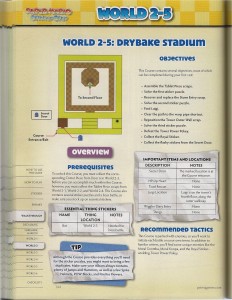
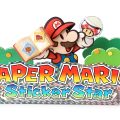
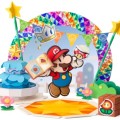
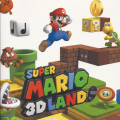
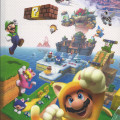
Leave a Reply